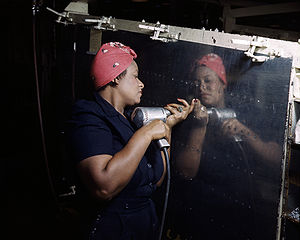
Back روزي المبرشمة Arabic ৰ'জি দ্য ৰিভিটাৰ Assamese Çəkicvuran Rozi Azerbaijani Rosie the Riveter Bulgarian Rosie the Riveter Breton Rosie the Riveter Catalan Rosie the Riveter Danish Rosie the Riveter German Rosie la nitistino Esperanto Rosie the Riveter Spanish

Rosie the Riveter is an allegorical cultural icon in the United States who represents the women who worked in factories and shipyards during World War II, many of whom produced munitions and war supplies.[1][2] These women sometimes took entirely new jobs replacing the male workers who joined the military. She is widely recognized in the "We Can Do It!" poster as a symbol of American feminism and women's economic advantage.[3] Similar images of women war workers appeared in other countries such as Britain and Australia. The idea of Rosie the Riveter originated in a song written in 1942 by Redd Evans and John Jacob Loeb. Images of women workers were widespread in the media in formats such as government posters, and commercial advertising was heavily used by the government to encourage women to volunteer for wartime service in factories.[4] Rosie the Riveter became the subject and title of a Hollywood film in 1944.
- ^ Cite error: The named reference
Seattle Timeswas invoked but never defined (see the help page). - ^ Cite error: The named reference
LibConwas invoked but never defined (see the help page). - ^ Duncan, W. Raymond; Jancar-Webster, Barbara; Switky, Bob (2008). World Politics in the Twenty-first Century Brief (Student choice ed.). Boston: Houghton Mifflin College Div. p. 268. ISBN 978-0-547-05634-0.
- ^ Adkins Covert, Tawnya J. (2011). Manipulating Images: World War II Mobilization of Women through Magazine Advertising. Lexington Books. ISBN 9780739169261.
© MMXXIII Rich X Search. We shall prevail. All rights reserved. Rich X Search